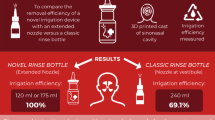Abstract
Nasal douches are applied in great number of diseases of the nose and the paranasal sinuses. For this purpose, many different kinds of nasal douching systems have been introduced into the market. The aim of this study was to examine the irrigation characteristics of the current nasal douching systems. In this context, 26 nasal douching systems were compared regarding irrigation volume, irrigation duration, flow rate and pressure and course of the irrigation stream. The following procedure was applied: First, the spontaneous flow through the nasal douche was measured, then the flow under compression. Finally, these procedures were repeated using a nose model. Furthermore, we asked the manufacturers for information concerning possible cleaning and disinfection techniques. Douching period and flow rate highly depend on physical parameters: distance between liquid column and outlet (hydrostatic pressure) and form and size of the outlet (energy loss because of friction/turbulence). A weak irrigation stream was found in spontaneous release of the douching system when both douching pressure and flow rate offered low values. The douching of the nose model showed that the incompressible nasal douches only reached the lower nasal passage. Only the compressible nasal douching systems led to a diffuse moisturization as well as to a perfusion of the entire nasal cavity. Systematic evaluation of the different recommended cleaning and disinfection methods of the nasal douching systems is still missing. Nasal douches are often recommended in many diseases of the nose and the paranasal sinuses. In this comparative in vitro study, physical parameters and material properties of the nasal douching systems were examined for the first time. For irrigation of the whole nasal cavity and paranasal sinuses, compressible douching systems are recommended which have a minimum output pressure of 120 mbar, a good connection of the outlet to the nostril with a possible insertion into the nasal vestibule and an irrigation stream which is directed upwards (45°). The material should be transparent, easy to clean and disinfect and should not contain harmful elements.






Similar content being viewed by others
References
Brown CL, Graham SC (2004) Nasal irrigation: good or bad? Curr Opin Otolaryngol Head Neck Surg 12:9–13
Fokkens WJ et al (2007) European position paper on rhinosinusitis and nasal polyps. Rhinol Suppl 20:1–136
Rabago D, Zgierska A (2009) Saline nasal irrigations for upper respiratory conditions. Am Fam Physician 80:1117–1119 (21–22)
Rosenfeld RM, Andes D, Bhattacharyya N, Cheung D, Eisenberg S, Ganiats TG, Gelzer A, Hamilos D, Haydon RC 3rd, Hudgins PA, Jones S, Krouse HJ, Lee LH, Mahoney MC, Marple BF, Mitchell CJ, Nathan R, Shiffman RN, Smith TL, Witsell DL (2007) Clinical practice guideline: adult sinusitis. Otolaryngol Head Neck Surg 137:S1–S31
Desrosiers M, Evans GA, Keith PK, Wright ED, Kaplan A, Bouchard J, Ciavarella A, Doyle PW, Javer AR, Leith ES, Mukherji A, Robert Schellenberg R, Small P, Witterick IJ (2011) Canadian clinical practice guidelines for acute and chronic rhinosinusitis. J Otolaryngol Head Neck Surg 40 Suppl 2:S99–S193
Harvey R, Hannan SA, Badia L, Scadding G (2007) Nasal saline irrigations for the symptoms of chronic rhinosinusitis. Cochrane Database Syst Rev 18:CD006394
Hermelingmeier KE, Weber R, Hellmich M, Heubach C, Mösges R (2012) Nasal irrigations as an adjunctive treatment in allergic rhinitis—Systematic review and meta-analysis. Am J Rhinol Allergy 26:119–125
Hildenbrand T, Weber R, Heubach C, Mösges R (2011) Nasal douching in acute rhinosinusitis. Laryngorhinootologie 90(6):346–351
Hildenbrand T, Weber RK, Brehmer D (2011) Rhinitis sicca, dry nose and atrophic rhinitis: a review of the literature. Eur Arch Otorhinolaryngol 268(1):17–26
Michel O (2006) Nasenspülung bei Rhinosinusitis. Laryngol Rhinol Otol 85:448–458
Schmidt T. Die tägliche Nasenspülung mit Salzwasser zur Vorbeugung und Behandlung von Atemwegserkrankungen. http://www.nasespuelen.de
Schmidt Th, Bitzer EM, Dörning H, Lüpsen H, Schwartz FW, Robra BP (2004) Tägliches Nasespülen reduziert Atemwegsbeschwerden - eine randomisierte Crossover-Studie. Gesundheitswesen :66. doi:10.1055/s-2004-833862
Georgitis JW (1994) Nasal hyperthermia and simple irrigation for perennial rhinitis. Changes in inflammatory mediators. Chest 106(5):1487–1492
Boek WM, Keleş N, Graamans K, Huizing EH (1999) Physiologic and hypertonic saline solutions impair ciliary activity in vitro. Laryngoscope 109(3):396–399
Talbot AR, Herr TM, Parsons DS (1997) Mucociliary clearance and buffered hypertonic saline solution. Laryngoscope 107(4):500–503
Weber R (2010) Nasenspülungen–Wirksamkeit und Indikationen. Eine Literaturübersicht. HNO kompakt 18:151–164
Beule A, Athanasiadis T, Athanasiadis E, Field J, Wormald PJ (2009) Efficacy of different techniques of sinonasal irrigation after modified Lothrop procedure. Am J Rhinol Allergy 23(1):85–90
Harvey RJ, Goddard JC, Wise SK, Schlosser RJ (2008) Effects of endoscopic sinus surgery and delivery device on cadaver sinus irrigation. Otolaryngol Head Neck Surg 139:137–142
Harvey RJ, Schlosser RJ (2009) Local drug delivery. Otolaryngol Clin North Am 42:829–845
Miller TR, Muntz HR, Gilbert ME, Orlandi RR (2004) Comparison of topical medication delivery systems after sinus surgery. Laryngoscope 114:201–204
Lee JM, Nayak JV, Doghramji LL, Welch KC, Chiu AG (2010) Assessing the risk of irrigation bottle and fluid contamination after endoscopic sinus surgery. Am J Rhinol Allergy 24(3):197–199
Welch KC, Cohen MB, Doghramji LL, Cohen NA, Chandra RK, Palmer JN, Chiu AG (2009) Clinical correlation between irrigation bottle contamination and clinical outcomes in post-functional endoscopic sinus surgery patients. Am J Rhinol Allergy 23(4):401–404
Keen M, Foreman A, Wormald PJ (2010) The clinical significance of nasal irrigation bottle contamination. Laryngoscope 120(10):2110–2114
Conflict of interest
The authors declare that they do not have a financial relationship with any organization that sponsored the research.
Author information
Authors and Affiliations
Corresponding author
Rights and permissions
About this article
Cite this article
Campos, J., Heppt, W. & Weber, R. Nasal douches for diseases of the nose and the paranasal sinuses—a comparative in vitro investigation. Eur Arch Otorhinolaryngol 270, 2891–2899 (2013). https://doi.org/10.1007/s00405-013-2398-z
Received:
Accepted:
Published:
Issue Date:
DOI: https://doi.org/10.1007/s00405-013-2398-z




